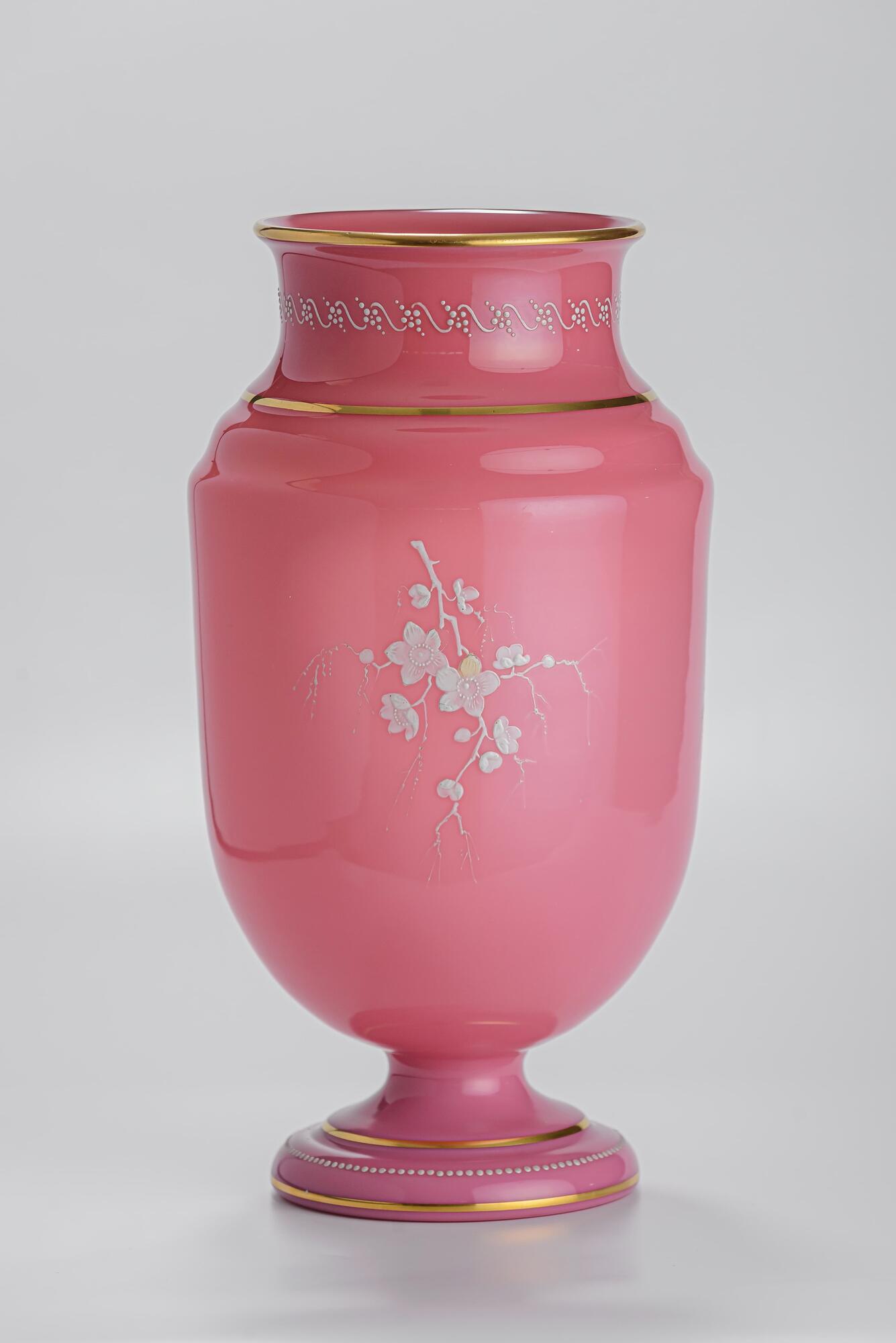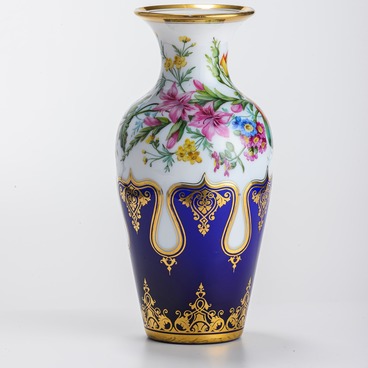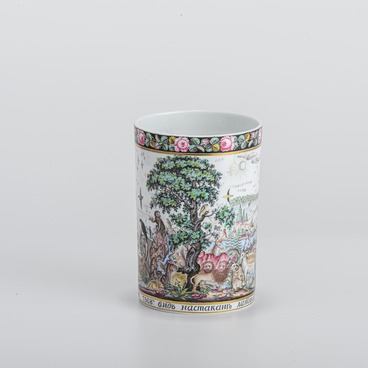The decorative vase “Pink” is a vivid example of glassware of the second half of the 19th century, the so-called era of imitations. It is made of opaque pink milk glass and painted with white enamel paints. The painting is made in the oriental style, typical for Russian glassmaking from the 1860s through the 1890s. On one side, on the body of the vase, the artist depicted a large graceful branch with flowers, birds sitting on it and butterflies fluttering nearby. On the reverse side, there is a small branch with three blossoms. The main image is complemented by enamel “beads” on the foot of the vase and a motif on the neck — slanted S-shaped scrolls and dotted flowers between them.
The opaque pale pink color can be obtained by using a mixture of the “gold ruby” dye and bone meal. It was the Russian scientist Mikhail Vasilyevich Lomonosov who developed decorative “gold ruby” glass.
In the 18th and 19th centuries, colored glass occupied an important place in the glass industry. It was first used at the Imperial Glass Factory, and soon the discovery spread to private enterprises. At the First All-Russian Manufactory Exhibition in 1829, colored glass products attracted no less attention than crystal. The palette was constantly expanding; new recipes were developed. “Copper ruby” appeared in addition to the “gold ruby”. It also rendered the glass a ruby-red color, but to obtain it, a colloidal solution of copper, not gold, was added to the batch — a mixture of glass sand, soda and lime.
Black glass was valued for its resemblance to the jet gemstone, uranium glass (colored with uranium compounds) — for its mysterious green glow, and opal glass — for its change of yellow and blue tones depending on the lighting. In addition, there were glasses with aventurine inclusions, as well as internal marble-like and agate structures.
The “Gold Ruby” remained the most expensive of the colored glasses. According to factory price lists, “gold ruby” glassware was 50% more expensive than white, green, purple, orange, dark and light blue glass products. The second place in terms of cost was occupied by “copper ruby” and “uranium glass” — these products were 25% more expensive than others.
A special niche was occupied by frosted glass imitating the “stone”. The manufacturing took after the Chinese “stoneware” known in the 18th century.
In 1865, the All-Russian Manufactory Exhibition was held in Moscow. The artists of the Nikolsko-Bakhmetevsky factory presented objects made of “marble” and colored glass. For these products, the factory received the highest award — the right to place a stamp with the state emblem on its signs and products.
The opaque pale pink color can be obtained by using a mixture of the “gold ruby” dye and bone meal. It was the Russian scientist Mikhail Vasilyevich Lomonosov who developed decorative “gold ruby” glass.
In the 18th and 19th centuries, colored glass occupied an important place in the glass industry. It was first used at the Imperial Glass Factory, and soon the discovery spread to private enterprises. At the First All-Russian Manufactory Exhibition in 1829, colored glass products attracted no less attention than crystal. The palette was constantly expanding; new recipes were developed. “Copper ruby” appeared in addition to the “gold ruby”. It also rendered the glass a ruby-red color, but to obtain it, a colloidal solution of copper, not gold, was added to the batch — a mixture of glass sand, soda and lime.
Black glass was valued for its resemblance to the jet gemstone, uranium glass (colored with uranium compounds) — for its mysterious green glow, and opal glass — for its change of yellow and blue tones depending on the lighting. In addition, there were glasses with aventurine inclusions, as well as internal marble-like and agate structures.
The “Gold Ruby” remained the most expensive of the colored glasses. According to factory price lists, “gold ruby” glassware was 50% more expensive than white, green, purple, orange, dark and light blue glass products. The second place in terms of cost was occupied by “copper ruby” and “uranium glass” — these products were 25% more expensive than others.
A special niche was occupied by frosted glass imitating the “stone”. The manufacturing took after the Chinese “stoneware” known in the 18th century.
In 1865, the All-Russian Manufactory Exhibition was held in Moscow. The artists of the Nikolsko-Bakhmetevsky factory presented objects made of “marble” and colored glass. For these products, the factory received the highest award — the right to place a stamp with the state emblem on its signs and products.


